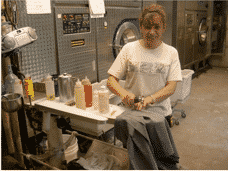“Invisible” and Other Stains
Most stains occur when foods and beverages are spilled or oily substances are splattered on clothing. Beverage stains can be deceiving, since they often become “invisible” after the beverage is blotted up and the area dries. Later on, however, with exposure to heat or the passage of time, a yellow or brownish stain will appear.
This is caused by the oxidation of sugar which is found in most beverages. You have probably seen this phenomenon with peeled apples that turn brown after being exposed to the air for a few minutes.
You can help us do a better job for you by pointing out such spillage when you bring in a garment to be cleaned. We often treat these stains prior to cleaning, since the heat of drying or finishing may set the stain.
When an oily substance, such as cooking or vegetable oil, is exposed to heat or ages in a garment for an extended period of time, it also oxidizes. This type of stain can often be distinguished by the irregular “cross pattern” the oil makes when it follows the fabric fibers. Oily substances are usually successfully removed in drycleaning unless they are left to oxidize. Once they become yellow or brown, they become much more difficult to remove.
Other stubborn food-related stains are caused by common substances such as:
- Albumin, naturally found in meat, eggs, milk and fish
- Tannin, a natural staining substance in coffee, tea, and tomatoes (which accounts for spaghetti sauce stains)
- Tuneric, the key yellow ingredient in mustard (also found in curry sauces)
- Food coloring in soft drinks
- Natural dyes contained in wine, which can create blue, purple, red or even black stains
Perspiration Stains
Perspiration can also cause problem stains, particularly in silk and wool garments. Perspiration left in a silk garment, for example, can cause deterioration of the silk fibers. Repeated exposure to perspiration and body oils can create a permanent yellow discoloration and an objectionable odor. People who perspire heavily should have their clothes cleaned frequently and should consider using perspiration shields. Clothing that is worn often or heavily stained also required frequent cleaning.
Ink and Paint Stains
After foods and beverages, ink and paint are probably the most common stains. Many ink stains are removable, as are many stains caused by paint, nail polish, and cosmetics. Paint that is heavily built-up and dried-on, however, may be impossible to remove. In every case, a stain’s successful removal depends largely on the type of fabric and the colorfastness of the dye. Special chemicals and bleaches are needed to remove such stains, and some dyes and fabrics may not withstand the use of these agents.
Color Loss and Damage
Before you get dressed, make sure deodorants and perfumes dried completely. Alcohol in perfume can cause many dyes to bleed, causing a permanent color loss or dye ring. Salts in deodorants can stain and weaken some fabrics. Some stains are slightly acidic or alkaline in nature. These stains, even in small amounts, if allowed to remain on the fabric for long periods, can cause color changes and damage. Foods, beverages, and perspiration can cause this reaction. We can sometimes reverse these color changes if the stain is “fresh” only several days or weeks old. But the acid or alkaline content of the stain may have caused a permanent color reaction and also severely weakened the fabric covered by the stain. In some severe cases, fabric damage may occur while we are trying to remove the stain.

 Our approach to conducting business is different - we continually raise the bar of quality in the dry cleaning community. Recognized by the International Fabricare Institute for a true commitment to high dry cleaning quality, Executive Cleaners achieved a performance level that few dry cleaning companies achieve. The results were deemed "absolutely superb" by professionals in the industry. Frankly, we would accept nothing less.
Our approach to conducting business is different - we continually raise the bar of quality in the dry cleaning community. Recognized by the International Fabricare Institute for a true commitment to high dry cleaning quality, Executive Cleaners achieved a performance level that few dry cleaning companies achieve. The results were deemed "absolutely superb" by professionals in the industry. Frankly, we would accept nothing less.